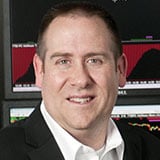Trader Rob Hoffman discusses one of his favorite trade set-ups, the "max range extension," which has yielded favorable results in both trending and non-trending markets.
After you’ve been trading long enough, you probably have a favorite strategy or a favorite type of trade that you like to do each day. Our guest today is Rob Hoffman to talk about his favorite type of trade. So Rob, talk about the favorite trade you like to do in the markets.
Yes, one of the favorite trades I have is called the “max range extension” trade. The reason why that trade is important to me is because it works in both trending and non-trending markets.
The premise of the trade is that I’m looking at hourly bars, and I’m looking to see how far within a one-hour period—from 9 o’clock to 10 o’clock, 10 o’clock to 11 o’clock—how far over the period of the last three months we’ve been able to extend those bars within one hour.
So, for instance, like crude oil, can we go 20 ticks within an hour? And this is from the open of the bar to the high, or the open to the low. How far can we extend that bar?
The reason why that’s important is because what I do then is put together a statistical profile. It’s very simple, actually.
I just pull out an Excel spreadsheet from my data vendor for the charting program, the open-high-low-close, and then use an Excel spreadsheet to determine the open to the high, open to the low, and what I do then is I just refer basically three months back, a look-back period, so every month I go back for the last three months, and then the next month, so this way it always incorporates the newest month’s worth of data.
What’s important here is that I’m looking then to find the top 2% of ranges that the market extends into. I like to take trades at around what they call the “98 percentile.”
This is a real live example: One week, I took a trade in crude oil. The market spiked up 200 ticks within one hour, and 200 ticks falls into precisely that 98 percentile, so in other words, 200 ticks is more than the other 98% of the bars.
Only 2% of the bars went more than 200 ticks within one hour, so what I’m really trying to do is stack the probabilities. Where is this market likely to be overextended, exhausted, and where could I place a trade against that trend that is likely to work in my favor based on the statistical probability over the last three months?
Interview Continues on Page 2
|pagebreak|It’s a great trade because it works in a non-trending market when there is no trend. Those extensions will have a quick spike up, a false breakout, and then it’s a great opportunity to short or go long and then have the market settle back in as it reverts back to the mean.
In a trending market, what’s nice is if we’re in an uptrend and have a rapid spike back down into that 98 percentile that’s near support, now I’ve got that great, 98-percentile-type trade along with support right down there as well.
So, the way it’s calculated, again, is basically just going in and taking the open to the highs for three months and the open to the lows for three months and determining what number falls into the 98 percentile or better.
And it turns out that most of the time it will come back to the reversion? It almost sounds like a mean-reversion theory.
That’s basically the concept. I just put a little more science around it as far as when that trade is actually most likely exhausted itself. Now, if you want to be even more conservative with the trade, you can wait until it falls into the number that is 98 percentile.
Let’s say in crude oil, because over the last three months, we’ve had even a 400-tick bar in an hour, so if you wanted to get a little higher up, like 99.5%, maybe you can wait until it moves 300 or 320 ticks in an hour.
What’s nice is you can do this from home. You can pull down the data from your data provider and then use an Excel spreadsheet to just determine the difference between the open to the high, open to the low, and then you can do it that way.
Or, the old school way of doing it—which I did for years until people showed me how to do it myself with an Excel spreadsheet—I would eyeball the different numbers and then just kind of write down the bars that stood out to me and go ahead and determine which ones really stood out, and that’s how I would take those trades.
So, it’s a neat opportunity because it works in trending and non-trending environments.
Related Reading:





















